Football can be a confusing game and with the huge number of positions on both offense and defense it can be tough to keep up. In this article, we are going to go over all of the defensive positions on a football team.
Each defensive position has a unique set of responsibilities that make them crucial to the team. Read on to find out what role each position plays in the defense.
Defensive positions in football include cornerbacks(2), safeties(2), linebackers(3 or 4), defensive ends(2), and defensive tackles(1 or 2).
To make things easier to understand we are going to break down defensive players into three main categories the secondary, the linebackers, and the defensive line.
The secondary
The secondary in football refers to the defensive positions which primarily stop the opposing team from completing long passes. These players generally line up the furthest back from where the ball is snapped.
Included in the secondary are safeties and cornerbacks.
Safeties
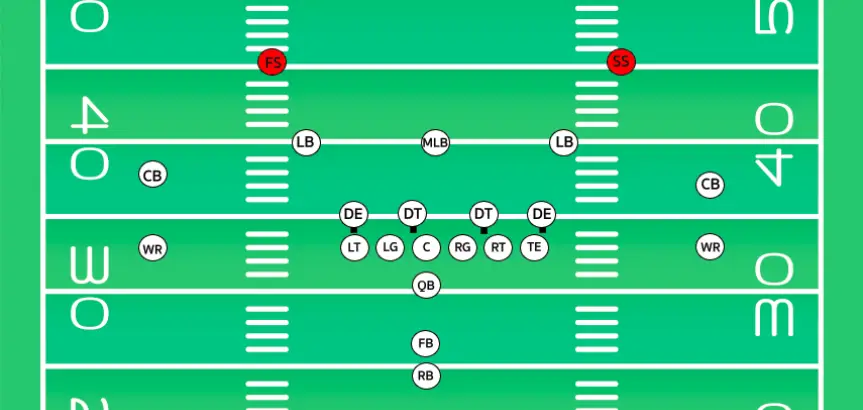
FS (full safety) SS (strong safety)
In football, there are usually going to be two defensive positions referred to as safeties. These two safeties are named the free safety and the strong safety.
The strong safety lines up on the side of the field that has more offensive players. Strong safeties will often protect one half of the field from long passes.
On plays where the offense runs the ball, strong safeties will often be tasked with making a tackle. This is because the ball is usually run to the side of the field that has more offensive players.
The free safety is the more conservative of the two safety positions. This position tends to line up the further back from the ball than any other player on the defense.
The free safety will often act as the last line of defense when it comes to stopping long passes or long runs.
These players often get a lot of interceptions due to how much time they spend in pass coverage.
Generally, there is one strong safety and one free safety on the field in football.
Cornerbacks

CB (cornerback)
Cornerbacks are the defensive players tasked with stopping the opposing team’s wide receivers.
A wide receiver is an offensive player who has the job of catching passes from the quarterback.
On any given play the cornerbacks will line up right in front of a wide receiver. Cornerbacks will be can be assigned man coverage or zone coverage on a play.
Man coverage means the cornerback will be assigned a player to cover for the entire play. They will follow this receiver around the field and make sure he does not catch a ball.
Zone coverage means the cornerback will be assigned a specific area of the field to cover. If any offensive player enters this zone the cornerback will make sure they do not catch a pass.
On rushing plays cornerbacks will attempt to get past the blocks of wide receivers and make a tackle. That being said cornerbacks tend to be much more involved in the pass defense than they are in the run defense.
Generally, there are two cornerbacks on the field. One lining up near each sideline in front of a wide receiver.
On some occasions, a team will add a third cornerback to the field when trying to stop the opponent from passing.
This third cornerback is referred to as a nickel corner and has a very similar role to the other cornerbacks.
Linebackers
Linebackers are the next position group we are going to cover in this guide to defensive positions in football.
This position typically lines up five to seven yards back from the ball and are heavily involved in both the pass defense and run defense.
Included in the linebacker position group are inside linebackers and outside linebackers.
There are going to be three of four linebackers on a defense depending on what formation they are using.
Linebackers are generally going to make three or four of the front seven players on a defense. The front seven is a term used to describe linebackers and the defensive line.
Inside linebackers
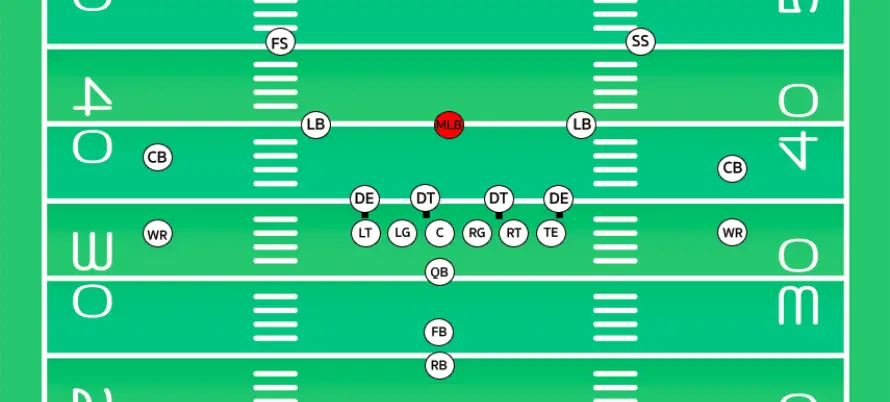
MLB (middle linebacker)
Inside linebackers line up in the middle of the formation and are often referred to as the quarterback of the defense.
Depending on the defensive formation there will be one or two inside linebackers.
These players play a large role in the run game and often lead the team in tackles.
On rushing plays inside linebackers are expected to step up towards the line of scrimmage and tackle the ball carrier once he gets through the defensive line.
On passing plays inside linebackers can be assigned man or zone coverage. Usually, these players will cover an area close to where the play started.
In man coverage inside linebackers will often be matched up with running backs.
One of the inside linebackers will get the duty of calling plays for the defense. This player will be the only defensive position player with a radio in their helmet (at the NFL level) which allows them to hear play calls from the coaching staff.
This inside linebacker will have to communicate this play call with the rest of the defense to get them ready for the next play.
Outside linebackers
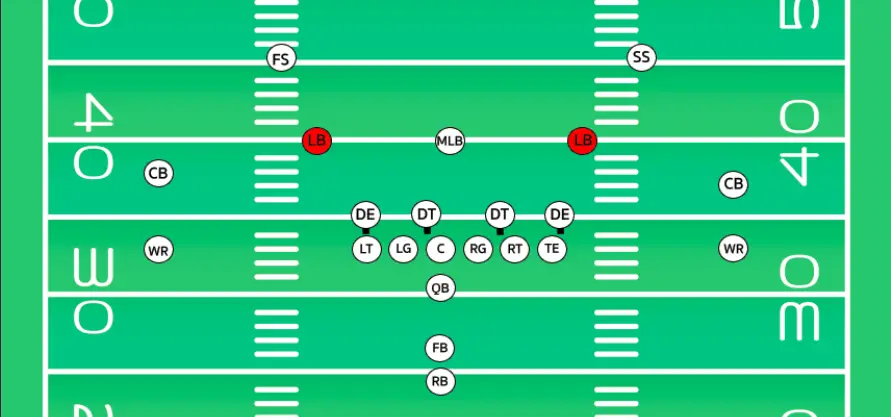
Outside linebackers make up the other half of the linebacker position group and are often much more involved in rushing the quarterback.
These linebackers will line up five to seven yards off the line of scrimmage on most plays.
In some defensive formations, the outside linebacker position is going to act solely as a pass rusher.
These players will line up right on the ball and will attempt to tackle the quarterback throughout the play. Recently they have been referring to players who play this role as edge defenders.
Other formations will have outside linebackers playing a more traditional linebacker role. These players will are expected to make tackles in the run game similar to an inside linebacker.
On passing, plays outside linebackers can also be put in to pass coverage. This usually involves them playing a zone or matching up against a slot receiver or running back.
Defensive line
The defensive line position is the last position group we are going to cover in our guide to understanding defensive positions in football.
Depending on the formation that is chosen by the defense there will either be three or four defensive linemen.
Defensive ends
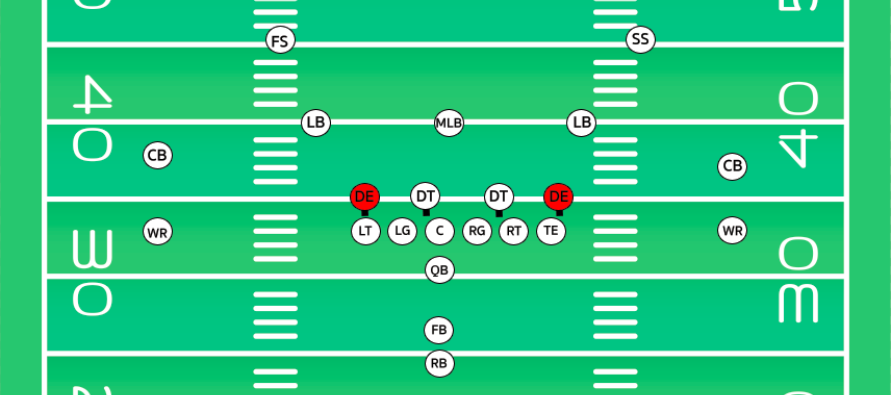
DE (defensive end)
Defensive ends are the players that are going to line up on the end of the defensive line. There will almost always be two defensive ends on a defense.
These players have the primary role of tackling the quarterback before he throws the ball. Since these players line up on the end of the defensive line they are often able to get a shot at the quarterback.
If they are able to get past the offensive tackle they can generate sacks which are a great result for the defense. For this reason, players that play this position are incredibly well paid if they can get to the quarterback.
On rushing plays, defensive ends are usually expected to contain their side of the field. This means they are going to make sure nobody gets outside of them.
If a defensive end plays on the left side of the field he is going to make sure the ball carrier does not get to the left sideline.
The defensive end position will funnel the ball carrier into the middle of the field so that other players on the defense will make the tackle.
Some defensive ends are known for their ability to stop the run but for the most part this position is known as pass rushers.
Defensive Tackle
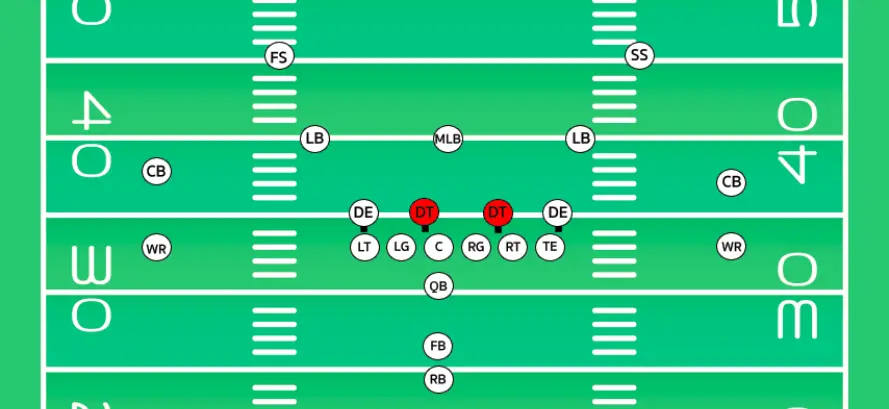
DT (defensive tackle)
The final position we are going to cover on the defense is defensive tackles. Defensive tackles are generally the largest players on the defense and line up right in the middle of the formation.
These players line up on top of the football just in front of the offensive line.
Some defenses will use two players at this position both lining up in the middle of the defensive line. Other defensive formations use one defensive tackle position which they refer to as a nose guard.
On rushing plays, these players are responsible for plugging up holes in the offensive line. On each running play, the offense will have a hole between offensive players in which the ball carrier will run through.
The defensive tackles need to identify where the offense is going with the ball and plug that hole. Since these players are strong and heavy it can be very difficult for the offense to move them.
Once the hole is plugged the ball carrier will be stuck in the pocket and likely be tackled for a loss.
On passing plays, defensive tackles are going to attempt to get to the quarterback. Since they are in the middle of the defense these players often take on multiple offensive linemen.
This makes it incredibly hard for these players to get to the quarterback. For this reason, defensive tackles do not tend to get many sacks.
Conclusion
The amount of information regarding defensive football positions can be confusing but it is easier if broken down.
Remember players in the secondary primarily stop their opponents from completing passes by covering receivers. These positions are safeties and cornerbacks.
Linebackers are the second level of the defense and play an equal role in pass coverage and stopping the run. This position group includes inside linebackers and outside linebackers.
The defensive line is the first line of defense and line up right on top of the ball.
These players rush the quarterback and try and contain the running back in the backfield. This position groups include defensive ends and defensive tackles.
That is all on defensive positions in football if you are looking to learn more see our guide to offensive positions in football.

